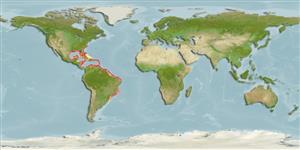Environment: milieu / climate zone / depth range / distribution range
Ecologia
marino demersale; distribuzione batimetrica 55 - 310 m. Subtropical
Western Central Atlantic: western and southern Gulf of Mexico and from Colombia to mouth of the Amazon River.
Size / Peso / Age
Maturity: Lm ? range ? - ? cm
Max length : 54.2 cm TL maschio/sesso non determinato; (Ref. 37039)
Vertebre: 227 - 245. Light yellowish brown, with small brown spots dorsally; vertical fins edged in black posteriorly (Ref. 37039).
Minimum depth reported from Ref. 37039.
Life cycle and mating behavior
Maturità | Riproduzione | Deposizione | Uova | Fecundity | Larve
McEachran, J.D. and J.D. Fechhelm, 1998. Fishes of the Gulf of Mexico. Volume 1: Myxiniformes to Gasterosteiformes. University of Texas Press, Austin. 1112p. (Ref. 37039)
IUCN Red List Status (Ref. 130435: Version 2024-1)
Threat to humans
Harmless
Human uses
Strumenti
Special reports
Download XML
Fonti Internet
Estimates based on models
Preferred temperature (Ref.
123201): 16.8 - 25.2, mean 20 °C (based on 118 cells).
Phylogenetic diversity index (Ref.
82804): PD
50 = 0.5020 [Uniqueness, from 0.5 = low to 2.0 = high].
Bayesian length-weight: a=0.00089 (0.00036 - 0.00222), b=2.98 (2.76 - 3.20), in cm total length, based on LWR estimates for this (Sub)family-body shape (Ref.
93245).
Trophic level (Ref.
69278): 3.4 ±0.5 se; based on size and trophs of closest relatives
Resilienza (Ref.
120179): Medio, tempo minimo di raddoppiamento della popolazione 1.4 - 4.4 anni (Preliminary K or Fecundity.).
Fishing Vulnerability (Ref.
59153): Moderate vulnerability (42 of 100).
